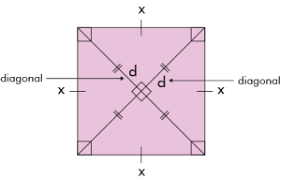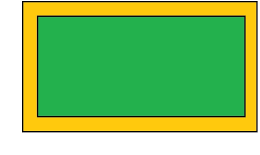
Area of Square
Area of a Square represents the total space it covers within its four equal sides. This concept is not just a part of geometry but a practical tool we encounter in daily life.
Whether it's figuring out how many tiles you need for your floor or determining the size of a garden plot, the area helps us measure and utilize space efficiently.
By learning to calculate the area, we can solve everyday problems effortlessly. In this article, we will explore the concept of the area of a square, including practical examples, formula of area of square, steps to calculate the area of a square using side and diagonal formulas, and its units.
Square in Maths
A square is a two-dimensional shape that belongs to the family of quadrilaterals. It is defined by four sides of equal length, with each interior angle measuring 90°.
The opposite sides of the square are parallel to each other. One of its unique properties lies in its diagonals, which are equal in length and intersect at right angles.
This symmetrical and balanced shape is found in many objects that we use in everyday life, such as tiles, photo frames, chessboards, tabletops, and more.

Properties of Square
Here are some common properties of a square:- A square has four sides and four vertices, making it a type of quadrilateral.
- All sides are of equal length, and opposite sides are parallel.
- Each interior angle measures 90°, and the sum of all interior angles is 360°.
- The diagonals are equal in length, bisect each other at 90°, and divide the square into two congruent triangles.
What is the Area of a Square?
The area of a square refers to the amount of flat space enclosed within its four equal sides. In other words, it helps measure how much surface a square-shaped object occupies. For example, think of a square garden. The area of the garden represents the total space available within its boundaries for planting grass, flowers, or other decorations. The unit of measurement for area is always in square units, such as square meters, square centimeters, or square feet.What is the Formula of Area of Square
The area of a square is expressed as the number of square units required to fill the square. Area is often defined as the space within the boundaries of a two-dimensional figure or flat object. Using square meters (m2) as the standard unit, the measurement is performed in square units. Now lets find the area of a square:
Area of square = Side × Side (square units)
Area of a Square Formula
The area of square formula helps calculate the space enclosed within its four equal sides. It is expressed as: Area of square = Side × Side (square units) If the diagonal of the square is given, the area of a square formula becomes: Area = (Diagonal²) ÷ 2 (square units)Example 1: Using the Side
Let’s consider a square garden with each side measuring 8 feet. Using the formula: Area = Side × Side = 8 × 8 = 64 square feet. The garden occupies a total area of 64 square feet.Example 2: Using the Diagonal
For a square photo frame with a diagonal of 10 inches: Area = (Diagonal²) ÷ 2 = (10 × 10) ÷ 2 = 100 ÷ 2 = 50 square inches.Area of Square Formula Using Diagonal Derivation
The formula for finding the area of a square using its diagonal can be derived using the Pythagoras theorem. Let the side of the square be "a" units and the diagonal be "d" units. The diagonal divides the square into two equal right-angled triangles. In each triangle, the diagonal is the hypotenuse, and the two sides are the base and perpendicular.Area of a Square Solved Examples
Example 1: Find the area of a square if the length of the diagonal is 14 cm.First, find the area of the playground:
Area = Side² Area = 25 × 25 = 625mNow, calculate the total cost:
Total Cost = Area × Cost per square meter
Total Cost = 625 × 15 = $9375 The total cost to lay grass in the square playground is $9375.Find the area of the hall:
Area of hall = Side² = 50 × 50 = 2500m²Find the area of one tile:
Area of one tile = Side² = 5 × 5 = 25 m²Now, calculate the number of tiles needed:
Number of tiles = (Area of hall) ÷ (Area of one tile) Number of tiles = 2500 ÷ 25 = 100 The total number of tiles required is 100.Find the side length:
Side = Perimeter ÷ 4 = 60 ÷ 4 = 15 cmFind the area:
Area = Side² = 15×15 = 225 cm ² Calculate the total cost: Total Cost = Area × Cost per square cm Total Cost = 225 × 3 = $675 The cost to paint the square is $675. Join Online Tuition Class Now!!| Related Articles | |
| Area of Rectangle | Isosceles Triangle |
| Composite Numbers | Differentiation |
| Perimeter of Rectangle | Surface Area of Cylinder |
Area of a Square FAQs
How is the area of a square different from the perimeter?
Can the area of a square be negative?
Why is the area of a square measured in square units?
How can I visually understand the area of a square?
What happens to the area of a square if its side is doubled?










